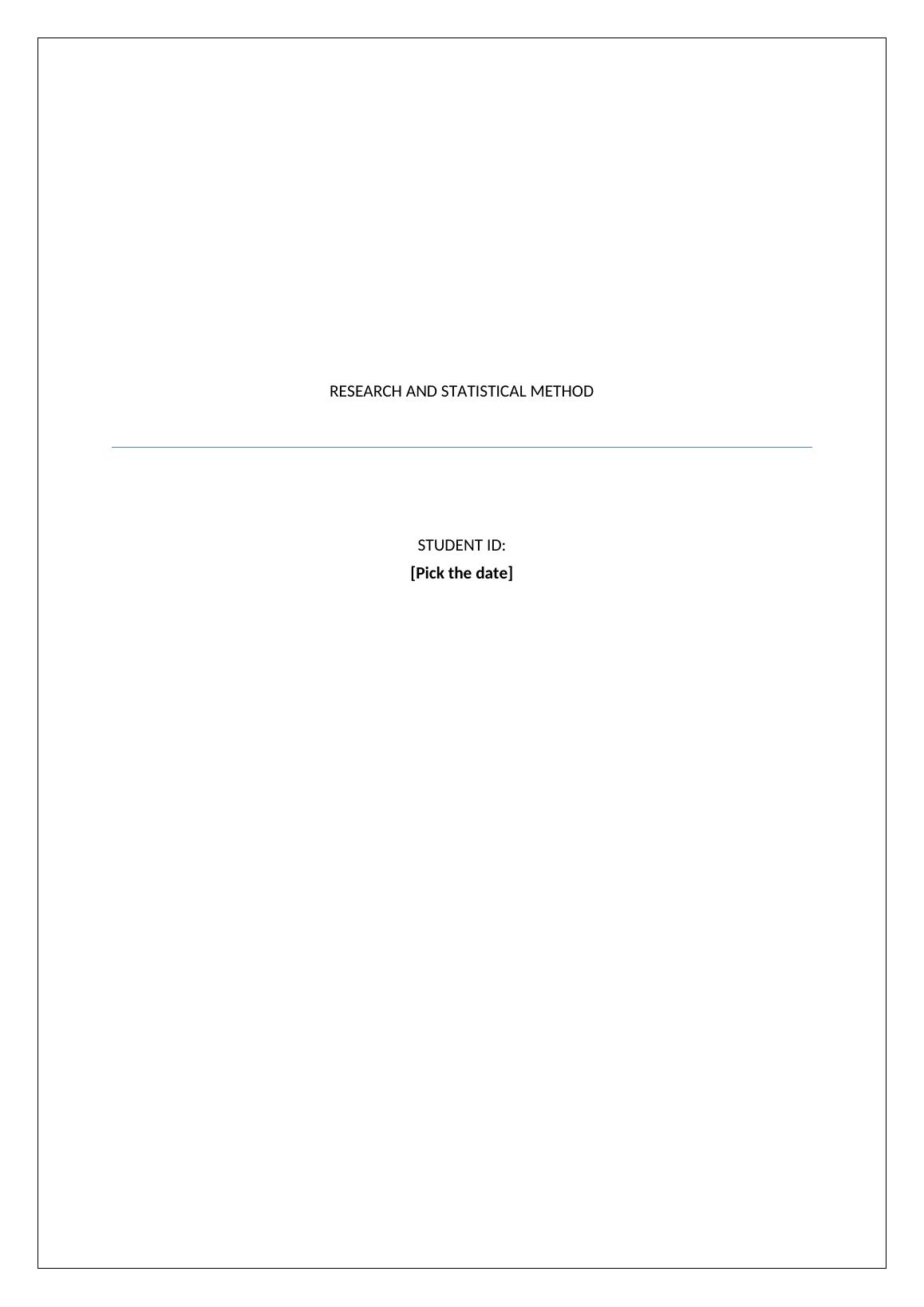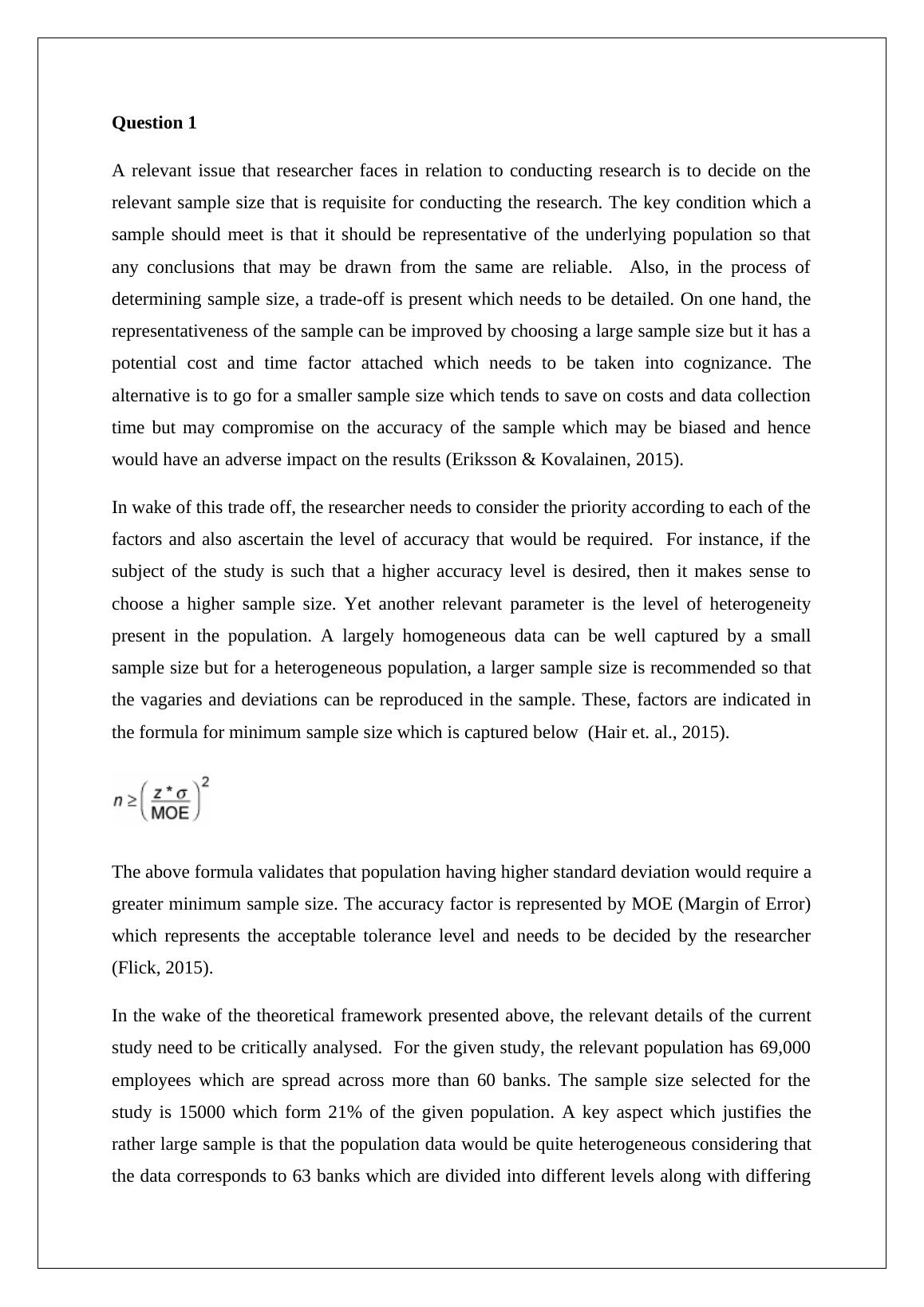Research and Statistical Method: Assignment
8 Pages2402 Words28 Views
Added on 2021-06-17
Research and Statistical Method: Assignment
Added on 2021-06-17
ShareRelated Documents
RESEARCH ANDSTATISTICAL METHODSTUDENT ID:[Pick the date]

Question 1A relevant issue that researcher faces in relation to conducting research is to decide on therelevant sample size that is requisite for conducting the research. The key condition which asample should meet is that it should be representative of the underlying population so thatany conclusions that may be drawn from the same are reliable. Also, in the process ofdetermining sample size, a trade-off is present which needs to be detailed. On one hand, therepresentativeness of the sample can be improved by choosing a large sample size but it has apotential cost and time factor attached which needs to be taken into cognizance. Thealternative is to go for a smaller sample size which tends to save on costs and data collectiontime but may compromise on the accuracy of the sample which may be biased and hencewould have an adverse impact on the results (Eriksson & Kovalainen, 2015).In wake of this trade off, the researcher needs to consider the priority according to each of thefactors and also ascertain the level of accuracy that would be required. For instance, if thesubject of the study is such that a higher accuracy level is desired, then it makes sense tochoose a higher sample size. Yet another relevant parameter is the level of heterogeneitypresent in the population. A largely homogeneous data can be well captured by a smallsample size but for a heterogeneous population, a larger sample size is recommended so thatthe vagaries and deviations can be reproduced in the sample. These, factors are indicated inthe formula for minimum sample size which is captured below (Hair et. al., 2015).The above formula validates that population having higher standard deviation would require agreater minimum sample size. The accuracy factor is represented by MOE (Margin of Error)which represents the acceptable tolerance level and needs to be decided by the researcher(Flick, 2015).In the wake of the theoretical framework presented above, the relevant details of the currentstudy need to be critically analysed. For the given study, the relevant population has 69,000employees which are spread across more than 60 banks. The sample size selected for thestudy is 15000 which form 21% of the given population. A key aspect which justifies therather large sample is that the population data would be quite heterogeneous considering thatthe data corresponds to 63 banks which are divided into different levels along with differing

demographic parameters. In this case, a selection of a lower sample size could lead to a non-representative sample selection and thus would lead to issues regarding validity andreliability (Hillier, 2016). Hence, the given sample size seems to be fair in wake of theheterogeneous nature of the underlying population along with the accuracy desired by theresearcher. Question 2The sampling method which has been used for the given study is simple random samplingsince a random sample of 15,000 has been selected from the given population with noclassification has been done for various demographic parameters. A characteristic of thissampling method is that every element represent in the population has an equal chance ofgetting selected. This has been facilitated in the given case through the use of addresses sincerandomly 21% employees have been selected by each bank and personalised envelops havebeen mailed by the employer to collect the data. Advantages 1)A key advantage of this method of sampling is the underlying convenience andrequirement of minimal knowledge. This is pivotal considering the scope of the givenstudy which involves selection of 15,000 employees (Flick, 2015).2)For each of the 63 banks, there has been no classification based on the key attributes andhence classification errors would not be witnessed which could be an issue in stratifiedrandom sampling (Hair et. al., 2015).3)This method is quite commonly used and tends to lead to representative sample selectionowing to samples being randomly selected. This is especially true when the sample size islarge enough (Eriksson & Kovalainen, 2015).Disadvantages1)One of the key issues in relation with simple random sampling is that in case ofheterogeneous population, the sample may not be representative. This is prevalent for thegiven study also since for neither of the banks there has been any quota for key attributessuch as employment level, gender and education level. In such a situation, it is possiblethat a particular gender or employment level may have a representation in the sample

End of preview
Want to access all the pages? Upload your documents or become a member.
Related Documents
Assignment | research and Statistical Methodlg...
|8
|2380
|17
Research and Statistical Methods for Business Assignmentlg...
|9
|2465
|405
Research and Statistical Method - PDFlg...
|8
|2295
|85
Determining Sample Size and Sampling Method in Researchlg...
|8
|2422
|284
Research and Statistical Method: Sample Size, Sampling Method, Reliability, Control Variables, and Research Designlg...
|5
|753
|221
Methods of Sample Size Determination in Biostatisticslg...
|10
|629
|80
